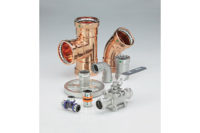
Much has been written about advanced computer technologies, but little has been written about their actual use by wholesalers in this industry and the benefits gained. So this author and the staff of Supply House Times decided to survey wholesalers and distributors on their use of advanced technologies.
The results show that wholesalers are not exactly on the bleeding edge of technology - only one technology was reported as being used by more than 50% of all respondents. However, several technologies are being widely used and some have been very beneficial. Let's look at the use, benefits and future of each technology.

THE SURVEY
With the help of the BNP Media research department, a short survey questionnaire was created and mailed to some 1,500 readers classified in the SUPPLY HOUSE TIMES database as a supply house or wholesaler. Exhibit 1 defines each technology, using roughly the same description as the questionnaire. Recipients were instructed to: classify their company into one or more of 10 “types”; record the number of employees and locations; indicate if each technology was used, and if so, record the level of benefit. Table 1 lists some of the types used in the questionnaire.More than 300 recipients responded, but due to missing or conflicting answers, only about 270 responses could be analyzed. Furthermore, some “types” included so few respondents that no statistically meaningful conclusions could be drawn; responses for these types were not broken out in Table 1, but were counted in the total.
Small sample sizes had their biggest impact on Table 2, which shows the level of benefit for each technology and type of distributor. Many “cells” are blank because the results would have a larger sampling error than the figures themselves. Only the type “Plumbing” had enough respondents to analyze the benefit of every technology.
Another caveat about survey results is that companies most involved with using high tech tend to respond in greater proportion than those not using high tech. Put another way, the reported level of use for all technologies may be higher than the actual level of use.
WHO'S USING WHAT AND BENEFITING FROM IT?
The following comments are based on Tables 1 and 2. (In reviewing the raw data, this author suspected that some recipients misinterpreted the definition of some technologies. Nonetheless, responses were analyzed as reported - sometimes producing odd results).Application Service Provider (ASP). This technology (or rather, use of technology) was supposed to replace wholesalers' computers and software, and it seems to be doing so. Or is it? The percentage of distributors using this form of “outsourcing” is surprisingly high, given that the arrangement is fairly new and many wholesalers don't want to be dependent on an outside party for this critical aspect of the business. On the other hand, it's not such a surprise given the true long-term costs of buying a modern, full-featured system. As Table 2 shows, most ASP users find the arrangement moderately to highly beneficial, which is good because a decent percentage of other wholesalers will indeed replace in-house systems with this pay-as-you-use method of processing.
Automatic Electronic Procurement. This is another technology where the extent of use is higher than expected - unless respondents confused this technology with EDI, which is not fully automatic and usually does not directly access a manufacturer's computer (but works through an intermediate company). The extent of use of this technology should be about the same as for the IDB, but it's double (which is surprising given the need for standard data and for expensive sophisticated software). Any confusion aside, the level of moderate plus high benefits is one of the highest reported, which is an endorsement of either EDI or automatic electronic procurement. If the level of use really is closer to that of the IDB, it's going to be a while before the majority of wholesalers use this technology; if the reported level of use really is this high, people-less purchasing will soon be here.
Bar Coding Without A Warehouse Management System (WMS). Cost is probably the reason that the average level of use across several types of wholesalers is not close to 50%. It's easy to spend more than $100,000 and then have to print and affix bar code labels on boxes that come without any. On the other hand, this technology can reduce errors and may increase productivity. But if the experience of “heating” wholesalers is any indicator, the benefits are not always there - that 30% “None” is one of the highest reported. Perhaps the low level of benefit is due to the large size of equipment handled; it's tough to lose or misplace large equipment, so there may not be a problem for bar coding to overcome. Yet the use of bar codes is expected to continue increasing even as RFID chips (addressed later) start showing up; the transition between the two technologies will take many years.
Computer Backup Arrangement. In the early days of computers the vast majority of wholesalers made such an arrangement. (Don't confuse a Backup Arrangement with backing up data - which is the process of copying data to another storage media, and a process that all wholesalers do religiously.) It's low now because today's computer hardware is very reliable, and some main computers contain redundant components, making them fail-proof (except in the event of a natural disaster, or lack of an uninterruptible power supply). And, back-up arrangements are not fully redundant for wholesalers with multiple locations - the remote locations usually are not connected to the back-up computer. Those who have such arrangements find them pretty beneficial, but the extent of use probably isn't going to grow much - all electronics and data-communications circuits are getting more and more reliable.
Direct Electronic Procurement. Just about every manufacturer has a Web site, and most such sites allow password-restricted purchasing, so it's no surprise that this technology is widely used. Actually, one should have expected a greater extent of use since the technology is widespread and the cost is so low - a wholesaler needs only one PC to purchase via a manufacturer's Web site. Almost every type of wholesaler purchases this way and most find it beneficial to highly beneficial. Look for this approach to grow before it then declines as various forms of automatic procurement gain wider acceptance.
Distributor Managed Inventory (DMI). This is another technology where there may have been some confusion over the definition - which implies that customers don't place purchase orders, wholesalers ship when the data indicates to do so. Compare the figures for DMI to those for VMI (Vendor Managed Inventory, described later), which is a much more established practice; it's not likely that DMI is used more than VMI. Yet just as some wholesalers see the benefit of VMI, some customers see the benefit of DMI. Its use should grow - but not at a large rate since few customers keep safety stock in case their wholesaler fails to deliver just in time.
E-Commerce. This is the most widely used of the technologies surveyed and is the only one where there were enough respondents in each type to show the level of benefit for each type. And the level of moderate to high benefit is one of the highest. Yet its average usage of 51% is disappointing in light of the relatively low cost of using some form of E-commerce - the cost of setting up an electronic catalog (on its own PC if needed) is much less than a car. If the growth of retail E-commerce is any predictor, expect its use by supply houses to grow substantially.
E-Commerce Exchange Procurement. This is supposed to be the way to get around the vendor-specific software customization that has, in part, constrained the growth of universal electronic purchasing - the exchange's computer translates any differences between a wholesaler's data and that of the partnering vendor. (Of course, if all the partners subscribed to the IDB, such translation wouldn't be needed). It has made a good start so far. But the data for “None” benefits indicates that several wholesalers, across five types, are not happy about this arrangement; perhaps some of those translations don't work so well? Don't expect it to grow quickly, but do expect it to grow.
E-Commerce Reverse Auctions. Someone once described this technology as a good way to lose money, so the low rate of participation is not a surprise. Actually, this author expected a lower rate, and didn't expect so many types of wholesalers to participate in this electronic form of bidding for business. In light of the high level of “None” benefits, this arrangement for reducing the bottom line is not likely to grow much, if at all.
Hardware Outsourcing. If so few wholesalers are willing to trust another company to “host” their business software, why are more willing to trust another company for both the hardware and the software - the ASP arrangement? And the higher level of “None” benefits (vs. that for ASP) makes the statistics for hardware outsourcing even more puzzling. Nevertheless, as with ASP, this technology will grow for the same reasons stated for ASP and because major hardware manufacturers and service providers are marketing it aggressively (e.g., IBM's TV ads for “business on demand”).
Industry Database (IDB from ASA). Survey results confirm the gist of the article, “Why Good Data Is Costing This Industry” (SUPPLY HOUSE TIMES July 2004, page 54) - too few ASA members subscribe to the IDB. Yet those who reported they do are getting the benefits described in the article: the benefits of standardized data. Look closely at the table and notice that IDB has the second highest level of “moderate” benefit! As the use of technologies such as electronic procurement and supply chain management grows, more and more wholesalers will be forced to subscribe. But non-subscribers who want to improve customer service and save money shouldn't wait to be “pushed.”
Offshore Computer-Support. This method of increasing high-tech unemployment in the United States is, so far, practiced by few of the providers of software for wholesalers; it's practiced by those providing software to the “Fortune 1000.” And although the providers are happy about reducing their operating costs, most of the wholesalers getting their support this way are very unhappy; the majority have obtained no benefit. The bad news is that the same technology that makes electronic procurement and other business practices worthwhile will enable this arrangement to spread geographically. And, as the acquisition of software providers continues, the new owners will undoubtedly shift software support abroad. As the user base grows from a few hundred to several thousand companies coast to coast, it's cheaper and easier to provide 24/7 support from abroad.
Radio Frequency Identification (RFID). Look at Exhibit 2, an update on the status of RFID. Now, have 14% of respondents really been notified to expect chips on pallets, etc.? None of the vendors to this industry has been mentioned in any news releases about RFID. Maybe respondents confused “RFID” with the “RF” used by devices that read bar codes? Putting the question of accurate survey responses aside, RFID is coming and 2006 is the year in which wholesalers will be receiving those notices and start receiving items with chips on or in them. But expect a long transition away from bar codes, so hold onto those code readers.
Supply Chain Management (SCM). For details about SCM, see the article in the October 2002 issue of SUPPLY HOUSE TIMES, page 58. Considering the definition of SCM used in the questionnaire, it's questionable that 23% of respondents are really involved in this kind of close partnering and that every type is involved. It's much more likely that only a few of the elements of SCM are being used by the partners; for example, the occasional exchange of information between wholesalers and manufacturers. Because of the cost and complexity of this technology, true SCM is likely to grow very slowly in this industry.
Vendor Managed Inventory (VMI). This established practice has been growing slowly over the last 10 years or so (and may have been what some people had in mind when answering the question about SCM). Compared to other industries, the level of VMI is low - few wholesalers are willing to allow manufacturers to decide when to ship and the quantity. But VMI is likely to continue growing, though like SCM, not at a fast rate.
Warehouse Management System (WMS). This technology includes Bar Coding, addressed earlier, and the two together are very costly. So the extent of use is a little surprising, as is the level of no benefits. Managing PVF may pose a challenge for any WMS. Yet the cost of technology continues to decrease at a slow rate, which over time will motivate more wholesalers - but not all - to install WMS systems; the emergence of RFID will increase the level of motivation.
Wireless Technology In The Field (WiFi). Even though many commercial places have WiFi arrangements, the extent of reported use is still somewhat surprisingly high. But, having only one wireless laptop in use allowed a respondent to say “yes” to this technology - even if there were dozens of non-wireless laptops in use. In any case, the benefits have been good, though not as “high” as other technologies. The use of wireless portable devices will continue growing at a fast pace (as service providers switch over to the faster WiMax method, which also allows devices to be thousands of feet away from the “router.”).
Wireless Technology On Premises. Apparently, replacing jumbles of cables in the office with wireless is not as worthwhile as using a laptop while waiting to board a plane - and one of these days, while in flight. Actually, the levels of in-house and in-field use are statistically tied, as are the levels of benefits. But expect in-field use to grow more, because the need is greater - you can't put a laptop at the end of an infinitely long cable.
TECHNOLOGY AND WHOLESALER SIZE
It might be helpful to see if the use of technology increases with the size of each type of wholesaler. Unfortunately, there are too few respondents for any type but “Plumbing,” for which the results are shown in Tables 3 and 4. With three exceptions, the more locations (Table 3), the greater the use of a technology. The extent of use of Hardware Outsourcing is about the same regardless of size, and for two technologies, the extent of use is smaller for the one-location wholesalers and those with 10 or more: Offshore Computer-Support and RFID (where “use” must be treated with some skepticism). An analysis was also done for the level of benefit vs. the number of locations, and it showed that the benefit increases with size. But, two problems preclude a table: too many instances of sample size being too small to be meaningful; too many exceptions to the benefit/size correlation.
One would expect that the use of technology would increase with the number of employees -Table 4 shows that expectation to be correct. But there are far more exceptions to a strict use/size correlation than for Table 3. Still, the extent of use is lower for those with less than 50 employees than for those with more. Using the under/over logic, there are only three technologies that don't fit that pattern: Hardware Outsourcing, Offshore Computer-Support and RFID. When it comes to the level of benefit vs. the number of employees, there are so many combinations that contain too few “counts” to be meaningful that even broad conclusions can't be drawn. <<
Exhibit 1: DEFINITION OF EACH TECHNOLOGY
Application Service Provider (ASP)Data processing is done using the off-site hardware and software of a company that is in the business of providing data processing to others.
Automatic Electronic Procurement
Wholesaler's computer automatically accesses a vendor's computer and transmits a purchase order - without any human involvement.
Bar Coding Without A Warehouse Management System (WMS)
Bar code scanners capture item and location data during receiving, put away, picking, shipping and physical counting; no WMS software is involved.
Computer Backup Arrangement
Wholesaler has arranged with an outside service to process its data if its system is down.
Direct Electronic Procurement
Personnel purchase by accessing a vendor's Web site and keying-in purchase order data.
Distributor Managed Inventory (DMI)
Based on inventory data and sales data that a customer sends to the wholesaler, the wholesaler's system automatically determines what to ship the customer and the quantity.
E-Commerce
E-Commerce involves one or more of the following:
- Electronic catalog - visitors can view a list of items you sell, via clicking on an icon for a product line.
- Sales order entry - customers can enter sales orders.
- Sales order status - customers can view status data for their orders.
- Stock status inquiry - customers can view available quantities in stock.
- Customer-specific pricing - customers can view their specific final pricing.
E-Commerce Exchange Procurement
Personnel purchase by accessing a Web exchange and entering purchase orders for one or more participating vendors.
E-Commerce Reverse Auctions
Wholesaler has participated in online “auctions” in which wholesalers bid for business.
Hardware Outsourcing
Wholesaler's software operates on the off-site computer of a company that is in the business of renting the use of its hardware to others.
Industry Database (IDB from ASA)
Wholesalers subscribe to IDB for product data & pricing, catalogs, images.
Manufacturer has submitted data to IDB to be distributed in standard format.
Offshore Computer-Support
When someone at wholesaler calls for telephone help, the helper is located in an overseas country.
Radio Frequency Identification (RFID)
One or more vendors have sent notices that as of a certain date, pallets will contain tiny computer chips that store item data.
Supply Chain Management
Wholesaler's system and those of trading partners are connected full time, constantly exchanging information used for planning (e.g., production) and for execution (e.g., wholesaler's system uses a customer's inventory data as the trigger for shipping).
Vendor Managed Inventory (VMI)
Based on inventory data and sales data that wholesaler company sends to a vendor, that vendor's system automatically determines what to ship the wholesaler and the quantity.
Warehouse Management System (WMS)
Special software and bar code scanners “recommend” where to put away receipts, when to move items from bulk to picking area, how to rearrange the warehouse layout, and track warehouse productivity.
Wireless Technology In The Field
Wholesaler's laptops and PDAs that are taken off-site access the Internet (and the company's system) via a wireless arrangement.
Wireless Technology On Premises
Wholesaler's on-site computers and/or printers are linked together not by cables but by wireless transceivers.
Exhibit 2: RFID UPDATE - DON'T LOOK FOR A CHIP IN A STORE NEAR YOU
Since this author's article explaining RFID was published (April, 2003 Supply House Times, page 32), the number of companies and government agencies adopting or mandating the use of “chips” has grown significantly. But the actual use of embedded chips is just beginning.Remember, RFID is an acronym for Radio Frequency Identification, which refers to a tiny computer memory chip that is attached to or embedded in an item. Each chip can store hundreds of pieces of data about the specific item (e.g., date of manufacture and batch number), and also can store data that can be changed by a wholesaler (e.g., ID of bin into which the item is placed upon receiving).
As required by Wal-Mart, its top 100 suppliers now ship product with one chip per pallet; all other suppliers will do so by year-end. The same is true for suppliers to Target and Albertsons, a supermarket chain. And, some Department of Defense suppliers are using chips at the pallet level.
Joining the list of mandators are Boeing and Johnson Controls (whose main business is making interior assemblies for car manufacturers, who are expected to soon become mandators).
When it comes to RFID at the individual piece or unit level, a group of drug manufacturers already experimentally places a chip on each bottle of some drugs. Data in the chip is tracked through selective partners in the supply chain, down to retail pharmacies (mainly to ensure that a bottle does not contain a counterfeit drug). Michelin is also experimenting at the piece level, embedding a chip in the sidewall of each tire made or sold in North America.
Outside of manufacturing and distribution, Delta Air Lines plans to affix chip tags to luggage by 2007. Even FedEx and UPS are studying the use of RFID. And, as George Orwell might have predicted, the Food and Drug Administration has approved chips that can be implanted in humans (and store medical data about the person).
Software developers (including Microsoft) are modifying their ERP/MRP software to support the reading and updating of RFID data - which involves both new kinds of data and far more data than before. Developers of operating systems (e.g., UNIX) have also changed their software to support RFID.
Progress will continue to be slow because of a lack of standards (the European Council has its standard, and there are at least two in the United States); the cost of chips (35 cents in volume, up to 70 cents in smaller quantities); and the cost and difficulty of integrating RFID technology into existing ERP/MRP systems.
The list of companies selling tags embedded with chips and chip reading/writing devices has grown and continues to grow - lured by a market that could buy billions of devices and many billions of chips.
But demand for RFID at the pallet level is still small, and demand at the case level or below is nonexistent. Over time, the use of RFID is expected to soar as volume drives down the cost of a chip and reading/writing devices.
- Dick Friedman


